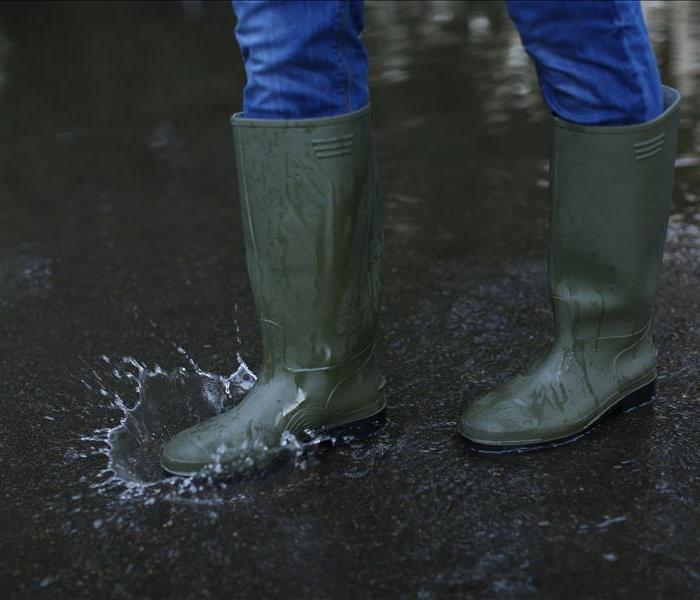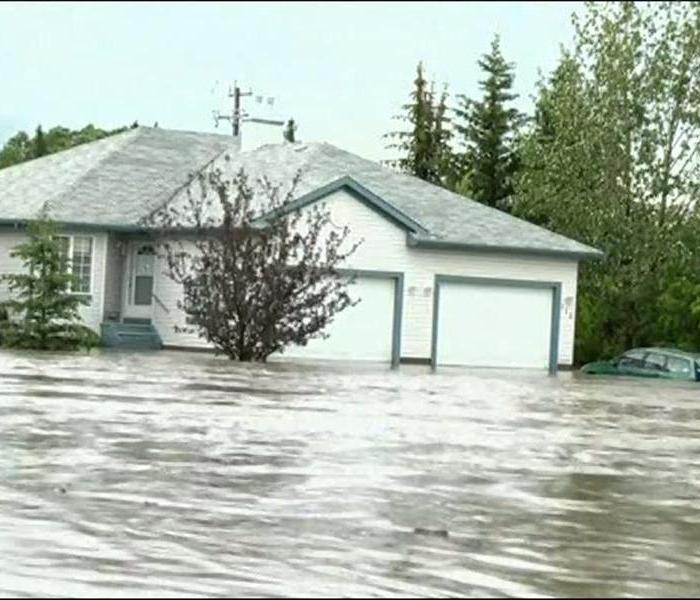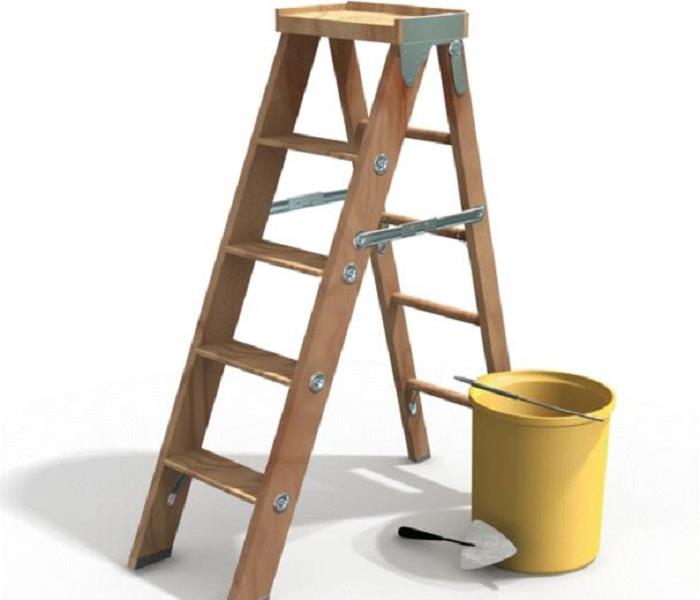Archived Water Damage Blog Posts
Flooded basement in Great Neck/Port Washington
7/5/2023 (Permalink)
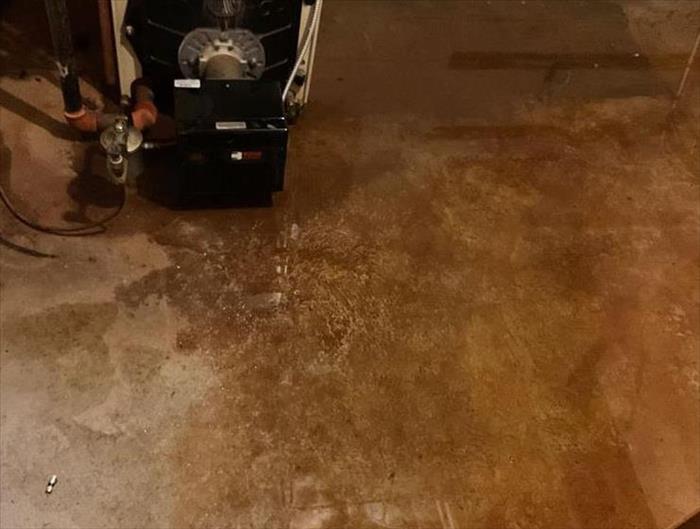 Flooded basement was caused by old expansion tank
Flooded basement was caused by old expansion tank
Customers expansion tank on the boiler blew.
This left her basement floor and walls to take on water damage.
Being that the basement had no dehumidifier prior to the event this caused mold growth, and condensation all around the basement walls and ceiling.
SERVPRO came in and removed all wet contents. We set up air scrubbers and a dehumidifier to dry out the remaining moisture. This elderly customer who never goes into her basement has terrible health and she was so concerned over the mold. We worked quick and made sure to take care of all her concerns.
Great Neck Water Damage Tools and Approaches
12/14/2022 (Permalink)
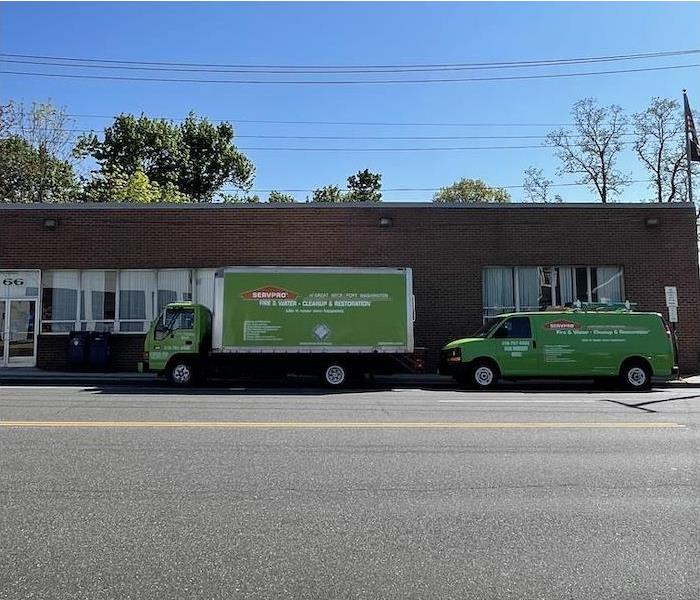 Day or night, SERVPRO is always on call to handle your water damage emergencies in Great Neck!
Day or night, SERVPRO is always on call to handle your water damage emergencies in Great Neck!
SERVPRO Helps Quickly After Water Damage
The water restoration process requires several actions to return the damaged property to its original condition. Our professionals are among the most heavily trained and educated as WRT-certified technicians through the IICRC and strictly adhering to the recognized standards of ANSI regulations for:
- Water removal
- Drying
- Content cleaning
- Structural repair
- Mold prevention
- Deodorization
We’re Faster To Any Size Disaster – this is more than a slogan to our team for Great Neck water damage incidents. It is a commitment we uphold every day through every project that we begin or continue through completion. We want customers to understand that they are the priority, and our objective is to return to normal living conditions as swiftly as possible. Proper restoration involves multiple focuses by our responding team.
Priorities of Water Damage Restoration
Our SERVPRO of Great Neck / Port Washington team must prioritize several restorative and mitigative actions beginning as soon as our response team arrives. With a consistent and focused progression through these phases, we can return properties to their preloss condition in reasonable timelines:
Extraction
Water removal services are a critical element of the mitigation process. Any standing water concerns become threatening presences to the exposed building materials involved, especially porous construction like carpets, drywall, and more. Pooling can be removed using several devices from our inventory, ranging in selected use by the depth of the damage and where trapped water exists. This can include:
- Submersible Pumps
- Wet Vacuums
- Carpet Wands
Drying
Drying is a necessary element of every water restoration process. Removing moisture is vital to the recovery of a household because lingering damp pockets and water caches in wall systems or on surface materials can support secondary damages like mold development or structural degradation. Evaporation and moisture content removal involves several specific devices from our stock, including:
These machines introduce focused airflow across moist surfaces and within damp environments. There are several types capable of managing specific conditions like low-profile centrifugal options.
Warming materials and the drying areas help amplify the production of evaporation and other needed chemical processes used for moisture removal, cleaning, and deodorization.
Evaporation increases water vapor in the environment, requiring several dehumidification units to be placed on the property to help. These machines act through condensation and absorption to lower humidity to acceptable parameters.
Trapped water in materials like hardwood and engineered wood flooring requires special drying tools to remove moisture through capillary suction.
Surface Cleaning
Cleaning up after a water damage issue involves the elimination of residues, microbes, and bacteria that might form on surfaces after prolonged water exposure. We must also present a suitable solution for deep cleaning carpeting throughout a property, as these fibrous flooring options can be heavily soiled.
Mold Prevention
Moisture continues to more than the destruction of exposed building materials. Damp conditions facilitate mold colonization and organism growth. There are early actions to be taken to help reduce, remove, and remediate mold damage, such as:
- Antimicrobial Products – Sporicidal and biocide sprays and solutions eradicate mold organisms and spores on contact.
- Managing Moisture – SERVPRO works to ensure water damage is resolved quickly to prevent lingering moisture that facilitates growth. We can also rebuild and repair vulnerabilities that allow recurring water infiltration.
- Third-Party Inspections and Testing – Third-party professionals can inspect and document impacted areas to identify if mold exists and the appropriate response of remediation professionals like our team to help.
Great Neck water damage incidents require fast and deliberate actions from trained professionals like our SERVPRO of Great Neck / Port Washington team. We are ready to help 24/7 at (516) 767-9600.
How Can I Remove Water Trapped Behind My Manhasset Fireplace Built-In Bookcases?
8/11/2022 (Permalink)
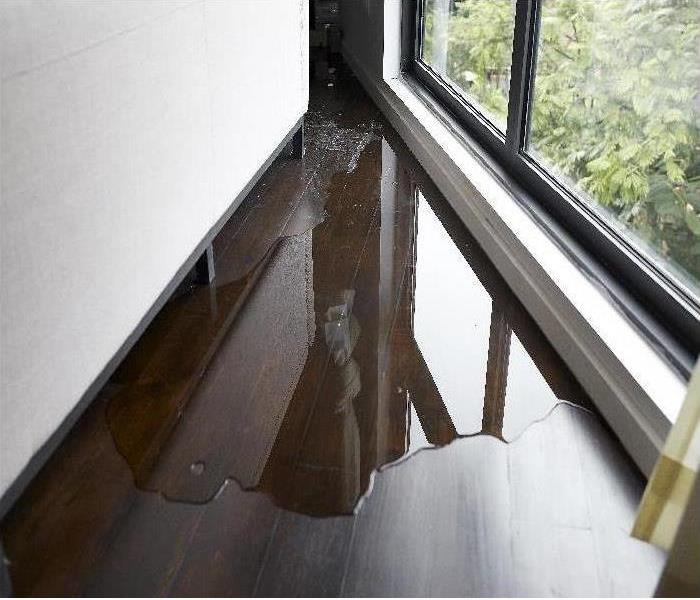 Count on the expertise of SERVPRO of Great Neck / Port Washington to solve challenging water damage scenarios.
Count on the expertise of SERVPRO of Great Neck / Port Washington to solve challenging water damage scenarios.
Research-Based Strategies at the Heart of Remediating Water Damage in Your Manhasset Home
Elegant, historic homes line the streets and estates in Manhasset, many featuring at least one fireplace framed by integrated bookcases and other beautiful woodwork. If the flashing, masonry, or brickwork around the top of the fireplace’s chimney develops leaking, the water can affect all building materials and fixtures below. Professional water removal and structural drying are a must to retain the integrity of your home.
My Books Are Wet! What Happened?
Water damage to Manhasset’s built-in shelves and bookcases is unexpected but always has a source, sometimes far away from the wet objects. Leaky roofs send water on rambling pathways through your home, and leaks near a chimney can permit moisture to percolate down several stories. You might hear dripping in the firebox or the lovely cabinets guarding each side of the fireplace absorb moisture. Books, china, and knick-knacks can all become wet while you scratch your head, trying to figure out why.
Are SERVPRO Crews Experienced in Chimney Leaking and Water Migration?
Our crew members master a comprehensive catalog of research-based best practices through the Institute of Inspection Cleaning and Restoration Certification (IICRC). SERVPRO is proficient at testing for water migration from the original leak to indirect damage or damage “upstream” to the leak. We use thermal imaging and moisture detectors and meters to map out the contours of the water incursion and gather data on where to focus extraction and structural drying.
How Do You Reach the Trapped Moisture that Is Damaging Fixtures and Personal Possessions?
Technicians look at the construction of the built-in shelving and cabinets, seeking the least disruptive way to remove toe kicks or baseboards to gain access to the interior. Often this shelving has bead-board as a backing which can be pried out to release water and allow for dry, warm air to reach wet materials to accelerate the evaporation of moisture. We try multiple approaches until one works.
Count on the expertise of SERVPRO of Great Neck / Port Washington to solve challenging water damage scenarios. Call (516) 767-9600 to schedule an assessment and planning session.
Professionals Should Handle Water Damage Repair in Great Neck
6/11/2022 (Permalink)
 From Great Neck water damage cleanup and restoration through the build back--SERVPRO has your back.
From Great Neck water damage cleanup and restoration through the build back--SERVPRO has your back.
Great Neck Water Damage Done Right
Water from leaks can disrupt your daily routine and damage your home. After a water intrusion incident, you need an experienced water restoration firm to deliver custom cleanup and restoration services.
SERVPRO can perform water damage repair on your Great Neck property. We know that time is a critical factor when recovering from water damage. That’s why we provide emergency response services around the clock.
You can count on SERVPRO to deliver high-quality work as a reliable water damage restoration firm. We can design a customized recovery and restoration plan for your home. Our water damage repair services may include the following steps:
- Finding and stopping the leak
- Water removal
- Drying and dehumidification
- Cleaning and disinfection
- Repairs and reconstruction
Finding and stopping the leak
Water can find its way through your residence’s walls, floors, ceilings, furniture, and other structures and contents. Our team can locate the leak and stop it.
Water removal
Effective water cleanup involves removing excess water from your home as fast as possible. Suppose the standing water in your property is two inches or deeper and does not have solid materials. In that case, we can extract it using submersible pumps with adequate volume capacity and lift capability.
Drying and dehumidification
Mold infestation can occur quickly in humid and damp conditions. Our SERVPRO technicians can implement a drying and dehumidification strategy to restore your home to a preloss state. We can use air movers to increase evaporation at the surface level and dehumidifiers to eliminate moisture from the air.
Cleaning and disinfection
Microbes can infest your property following water damage and degrade it. SERVPRO’s water damage cleanup technicians clean and disinfect the affected areas.
Repairs and reconstruction
After performing water removal, drying, and dehumidification, we begin the repairs and reconstruction phase. We can perform repairs like replacing damaged drywall or wood flooring or even a full-scale reconstruction of damaged areas.
It is normal to feel overwhelmed after an unexpected water leak in your home. You can trust SERVPRO of Great Neck / Port Washington to repair your property when that happens. Contact us at (516) 767-9600.
Water Damage In Your Manhasset Home
5/15/2022 (Permalink)
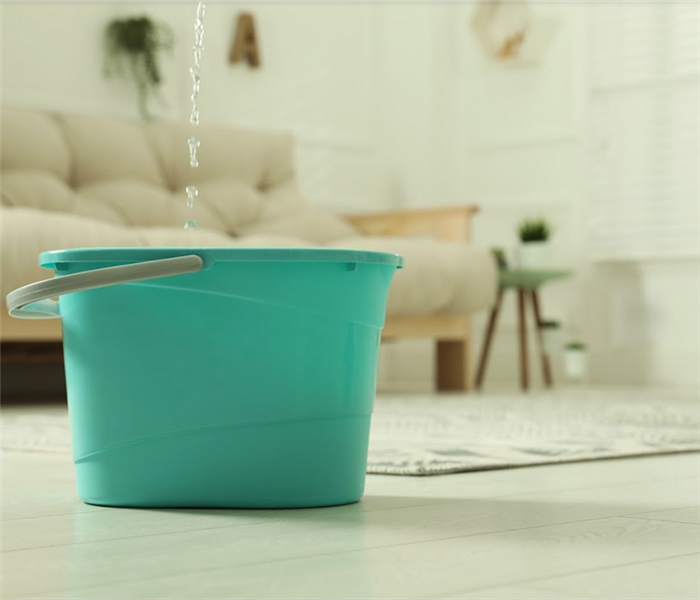 When a pipe bursts behind walls, excess water can quickly cause water damage. Contact our team to investigate the cause and then formulate a plan.
When a pipe bursts behind walls, excess water can quickly cause water damage. Contact our team to investigate the cause and then formulate a plan.
How We Handled Different Materials after Water Damage in a Manhasset Home
Water loss incidents can happen any time originating from any part of the home, including the obvious ones such as the bathroom or kitchen, but sometimes it starts from unexpected areas. For a homeowner in Manhasset, a pipe in the wall leaked at the joint, releasing gallons of water into the living room and spreading to other sections of the property affecting various materials.
Wet Carpet
Like in other water damage incidents in Manhasset, the water leaking from the walls collected on the floor, posing a significant threat to the floor materials. The sections with tiles could withstand exposure, but carpeted areas were more vulnerable to different issues, including matting of fibers, staining, delaminating, and even mold if left submerged for days. Our SERVPRO technicians opted to remove the carpet for better drying and to access the pad, which was unsalvageable.
Baseboards
Before removing the carpet, there was a need to remove some fixtures such as the baseboards and door trims, which would hinder the convenient or safe removal of the carpet. The trim is salvageable after water damage, so there is a need to remove it without causing damages. The good news is that it requires simple tools such as pry bars and crowbars to accomplish this, and our SERVPRO IICRC-certified technicians bring assorted tools in our production vehicles to every loss site. Other tools like knee kickers and carpet awls proved handy in dislodging the carpet faster once the baseboards and other trims were out of the way.
Engineered Wood
Despite our best effort, some materials could not be saved since they have adverse reactions when exposed to significant amounts of water. At the house, there were fixtures such as closets made of engineered wood affected by the water. Luckily, we could pry off the bottom panels using toe-kick removal without affecting other parts of the fixtures.
Saving materials affected by water damage is crucial. Call SERVPRO of Great Neck / Port Washington at (516) 767-9600 to help. We’re Faster to Any Size Disaster.
Water Damage In Your Manhasset Home
3/21/2022 (Permalink)
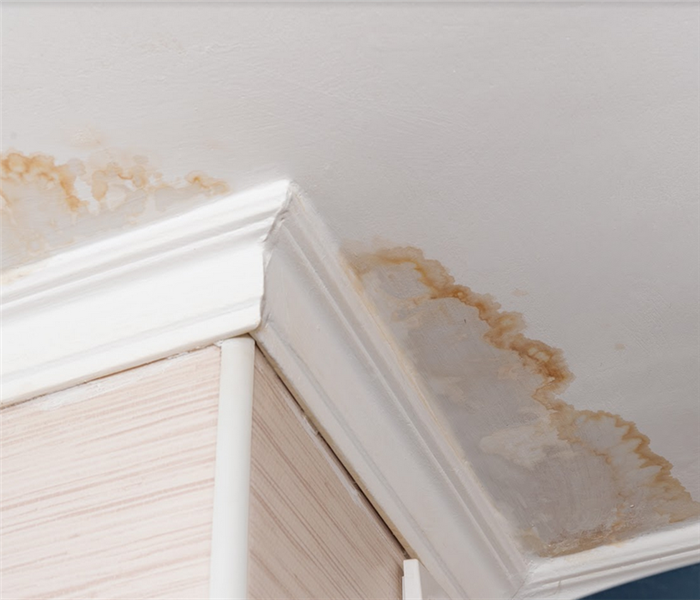 Whether water damage affects your home from above or below, team SERVPRO can remediate. Contact our technicians 24/7 - 365 days a year.
Whether water damage affects your home from above or below, team SERVPRO can remediate. Contact our technicians 24/7 - 365 days a year.
How We Handled Different Materials after Water Damage in a Manhasset Home
Water loss incidents can happen any time originating from any part of the home, including the obvious ones such as the bathroom or kitchen, but sometimes it starts from unexpected areas. For a homeowner in Manhasset, a pipe in the wall leaked at the joint, releasing gallons of water into the living room and spreading to other sections of the property affecting various materials.
Wet Carpet
Like in other water damage incidents in Manhasset, the water leaking from the walls collected on the floor, posing a significant threat to the floor materials. The sections with tiles could withstand exposure, but carpeted areas were more vulnerable to different issues, including matting of fibers, staining, delaminating, and even mold if left submerged for days. Our SERVPRO technicians opted to remove the carpet for better drying and to access the pad, which was unsalvageable.
Baseboards
Before removing the carpet, there was a need to remove some fixtures such as the baseboards and door trims, which would hinder the convenient or safe removal of the carpet. The trim is salvageable after water damage, so there is a need to remove it without causing damages. The good news is that it requires simple tools such as pry bars and crowbars to accomplish this, and our SERVPRO technicians bring assorted tools in our production vehicles to every loss site. Other tools like knee kickers and carpet awls proved handy in dislodging the carpet faster once the baseboards and other trims were out of the way.
Engineered Wood
Despite our best effort, some materials could not be saved since they have adverse reactions when exposed to significant amounts of water. At the house, there were fixtures such as closets made of engineered wood affected by the water. Luckily, we could pry off the bottom panels using toe-kick removal without affecting other parts of the fixtures.
Saving materials affected by water damage is crucial. Call SERVPRO of Great Neck / Port Washington at (516) 767-9600 to help. We’re Faster to Any Size Disaster.
Can Water Damage Restoration Help a Great Neck Crawlspace?
2/8/2022 (Permalink)
 Looking for a restoration company? Look no further, SERVPRO is just a call away at (516) 767-9600
Looking for a restoration company? Look no further, SERVPRO is just a call away at (516) 767-9600
SERVPRO Techs Have the Training to Remediate Great Neck Crawlspace Issues
Crawlspaces began as a way to buffer homes from the damp earth and have three advantages over a basement, including:
- Raises the house off the ground and assists in inhibiting moisture and termites
- More cost-effective than a basement
- The ductwork and mechanicals can run through the crawlspace, making them easy to service.
The problem with a Great Neck crawlspace is when it needs water damage restoration. When this home area takes on moisture, the result can be inviting a mold infestation.
The minute water gets discovered in a crawlspace, it needs attention, or substantial damage may occur. Knowing how the water enters can allow homeowners to take preventative measures to prevent this situation from occurring.
Grade
Water that runs towards the home rather than away can wind up inside the crawlspace. Hints that there is an issue with the grade around the house include pooling water after rains instead of positive drainage sloping away from the structure.
Flood damage
Residents who live near Little Neck Bay or Manhasset Bay may risk flooding. Large amounts of run-off may cause water to enter a crawlspace, and in these cases, professional extraction is the best option.
Plumbing Leaks
Plumbing for the home routinely runs through the crawlspace, and when there is a leak, it may be a long period before it gets noticed. Often a raised water bill is the first clue there is an issue in the house that starts the homeowner looking. Inspecting the crawlspace on a regular monthly schedule can avoid this issue becoming a huge problem. SERVPRO technicians can extract the water, dry crawlspaces, and perform encapsulation as needed to ensure none of these issues is a problem for the home in the future.
SERVPRO of Great Neck / Port Washington at (516) 767-9600 brings professional water damage restoration to the Great Neck community available 24/7.
What Is Involved in Conducting Water Removal in Great Neck?
1/20/2022 (Permalink)
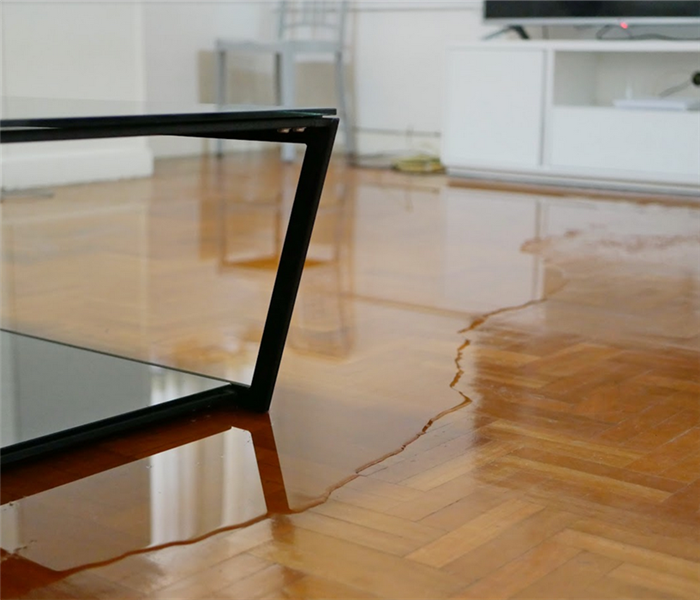 Team SERVPRO has the expertise and equipment to help with any type of water removal situation. Start the process right away for best results.
Team SERVPRO has the expertise and equipment to help with any type of water removal situation. Start the process right away for best results.
SERVPRO Provides Emergency Services for Water Damages in Great Neck
When most people think of removing water from a building, they think about a crew setting up pumps to pull out liquid H2O. Or, they may think that water extraction only involves mopping up moisture or vacuuming saturated carpets. However, whenever water makes its way into your dwelling, it not only builds up on your flooring it also can soak into your contents and building materials. And, due to the natural evaporation process, a water leak in your house can also raise your indoor relative humidity level.
When conducting water removal in Great Neck, our SERVPRO technicians know that the extraction process is just one of the steps involved in restoring your home to its preloss state. After we extract all of the liquids present in your home, we can then conduct the Applied Structural Drying (ASD) process.
During ASD procedures, we set up a combination of air movers and dehumidifiers. Since items in nature always want to move to equilibrium, setting up air movers so that they push air against your walls at a 45-degree angle will help water evaporate into the air from your wet items. The dehumidifiers then pull H2O out of the air and dispense it into liquid form.
Drying may take several days, depending on the severity of the issues. But, our SERVPRO team will keep returning until the moisture levels in your contents and building materials are normal. When restoring your property, we can provide the following:
- Heavy-Duty Water Extraction
- Water Clean Up
- Emergency Services After a Water Damage
- Water Damage Repairs
If you ever notice moisture sitting on your floors where it is not meant to be, call SERVPRO of Great Neck / Port Washington at (516) 767-9600.
Is Professional Water Restoration Sensible for Great Neck Homes?
10/19/2021 (Permalink)
 We are equipped to dry your water damaged home. Call us today!
We are equipped to dry your water damaged home. Call us today!
With a Finite Restoration Timeline, Professional Recovery for Water-Damaged Great Neck Properties is Worthwhile
There is a sense of urgency with any water damage event that could occur, even more with substantial emergencies like burst pipes or appliance ruptures. We have a team ready to respond immediately to showcase some of the many reasons professional restoration is cost-effective and efficient.
Emergency Services to Help the Property
Choosing water restoration companies for Great Neck water-damaged homes allows skilled professionals of our SERVPRO team to start emergency services as soon as we arrive. From relocating contents to beginning water removal services, swift action can make a difference in the length and cost of restoration.
Thorough Drying and Moisture Monitoring
After water damage incidents, the drying and cleaning up processes can be among the most intricate and thorough actions required for a compromised property. Missing moisture pockets during the drying process can allow for secondary effects like mold growth to occur. We rely on advanced moisture tracking equipment to monitor drying progress like:
- Thermal imagery (infrared)
- Moisture meters
- Hygrometers
Full-Service Damage Repair Solutions
Another advantage to choosing SERVPRO is our general contractor license. Because many water damage incidents threaten structural integrity like burst pipes or ceiling leaks, we can provide needed demolition and build-back services.
While you might not always think every situation requires professional restoration services, this approach has multiple benefits when water damage exists in your home. As widespread and overwhelming as these conditions can become, we have experienced professionals ready to mobilize 24/7 to help when you need it. You can reach our SERVPRO of Great Neck / Port Washington team today at (516) 767-9600.
What Do Water Mitigation Services for a Manhasset Home Entail?
7/29/2021 (Permalink)
 Don't let a ceiling leak in your Manhasset home upset you, just call SERVPRO
Don't let a ceiling leak in your Manhasset home upset you, just call SERVPRO
Manhasset Homeowners Should Expect Industry-Grade Equipment for their Water Remediation Needs
Water damage restoration services are not one-size-fits-all. Even though the basic steps involving water cleanup and water removal services are common to all water damage repairs, each situation warrants a plan tailored to its needs. Enlisting the help of a certified water restoration crew is the first step to a successful intervention.
Your certified water mitigation crew in Manhasset is available by calling SERVPRO and inviting its staff into your home. Our training and experience prepare us to handle damage due to a recent burst pipe or ceiling leak or tackle water damage repairs from erosion over time. Whatever the case is in your home, we offer the latest equipment and techniques recommended by the restoration industry best practices.
It is not uncommon for SERVPRO clients to find themselves in difficult situations because they failed to recognize the early warning signs of water damage. Aside from the evident presence of a leak or puddle, other telltale signs point to excess humidity. Some of those signs might include-
- Musty odor which you detect as you enter your home or inside closets or bedrooms
- Buckling or cupping of your hardwood floors which expand when air moisture levels fluctuate beyond normal readings
- Bubbling or brown spots on ceilings might indicate an attic leak and a higher concentration of humidity
- An inexplicably elevated water bill can also point to a consistent and long-lasting water leak that needs attention
SERVPRO of Great Neck/Port Washington provides water removal services and helps you sort through any necessary water damage repairs. Call us at (516) 767-9600 and invite us to leave your home “Like it never even happened.”
Great Neck Homes are Susceptible to Water Damage
7/12/2021 (Permalink)
 Help has arrived--The SERVPRO Team is ready to cleanup water damage in Great Neck
Help has arrived--The SERVPRO Team is ready to cleanup water damage in Great Neck
For Water Restoration in the Great Neck Area, SERVPRO is Ready to Help
Water restoration in a Great Neck home sounds like a long, tedious project, but that isn’t always the case. Homes of all ages and sizes can suffer water damage thanks to a ceiling leak, a burst pipe, or a broken appliance. Regardless of the origin of your problem, delegating the water damage repairs to a professional team is always sound advice.
The professional water restoration team in Great Neck, ready and equipped to handle emergencies of all sizes, is SERVPRO. Our technicians are trained and certified by the Institute of Inspection, Cleaning and Restoration Certification (IICRC), an independent entity that sets standards in the restoration industry. Our training, along with our field experience, sets us apart and prepares us to handle water emergencies of all sizes.
Many homeowners wonder if water removal is something they can handle on their own, and some well-intentioned ones go as far as renting equipment for water extraction.
Although removing standing water is a pivotal step in the process, it is not the only one, and you may risk leaving risk factors unresolved, which can later escalate into problems like mold.
To avoid those complications, SERVPRO takes a multi-pronged approach to water damage remediation, including-
- Water extraction- specialized equipment to remove the water, such as pumps, help us get rid of excess water in your home and belongings. If the volume warrants it, we can even connect to local sewers to dispose of it.
- Monitoring- tools like infrared moisture meters inform us of our progress and keep us working until target measurements are achieved. Our highly sensitive equipment takes out the guesswork from what we do and bases our decisions on sound scientific principles.
- Drying- water removal does not necessarily imply that humidity levels are back to normal. We use dehumidifiers, air movers, and desiccants until the job is done to finish drying your property.
Contacting SERVPRO of Great Neck/Port Washington at (516) 767-9600 is one of the best decisions you will ever make. Let our team of experts help you in your time of need and work for you until your home looks "Like it never even happened."
Call SERVPRO for Water Damage Mitigation with Rapid Removal and Drying
5/18/2021 (Permalink)
 A burst pipe in your home will cause havoc if not recognized quickly enough. SERVPRO has the manpower and equipment for any size water damage job.
A burst pipe in your home will cause havoc if not recognized quickly enough. SERVPRO has the manpower and equipment for any size water damage job.
When Water Damage Hits Your Great Neck Home -- Do This!
Not all water damage is catastrophic, but any excess moisture in your home can lead to many types of problems if not dealt with quickly. A water line leak in an upstairs bathroom, even if stopped right away, can lead to wet carpet in the hallway or nearby bedroom. Even worse, water seeping down into the first-floor ceiling.
If you find yourself with any type of water damage in Great Neck, no matter how minor or significant, the professionals at SERVPRO are here to help restore your home. We're Faster To Any Size Disaster. It is not always as simple as soaking up the spilled water with a towel.
If the water came from a water line, it is most likely clear, clean water needing removal. If the water is gray or black, in cases of contaminated water coming from a toilet overflow, the cleanup is different. Carpet and padding are removed in situations with contamination.
In most instances like this, with a clean water spill, you do not have to lose your carpet. In-place drying is an option, as long as there is no structural damage and no evidence of mold growth. In-place drying is ideal because there's less disruption to the home, and the carpet does not need to be completely pulled up. Some furniture may be relocated to a dry area or wax paper or blocks of wood or styrene placed under the legs.
The first step to drying the carpet is extracting all excess water. A truck mount extractor has the required strength to pull the most water out of your carpet and pads for large volumes of liquid. Typically, portable extractors and vacuums can capture most of the errant water. After extraction, technicians check the padding by gently pulling up a corner of the carpet to confirm no moisture. If they find moisture, they continue to pass over the wet areas. Monitoring to achieve the drying goals of the fibers is achieved with moisture meters and Thermo hygrometers.
Even minimal water leaks create excess moisture in the air. SERVPRO technicians, following IICRC guidelines and best practices, make sure the ambient moisture in your home is between forty to fifty percent through the use of our state-of-the-art equipment. Air movers ensure quicker water evaporation while our dehumidifiers condense water vapors to bring the ambient moisture down to optimal levels.
SERVPRO of Great Neck / Port Washington is here to assist you with water damage 24 hours a day, 7 days a week. Call us at (516) 767 -7600, so our team can make it, "Like it never even happened."
Basement Flooding of Manhasset Homes can be Dangerous when Left Unattended
4/18/2021 (Permalink)
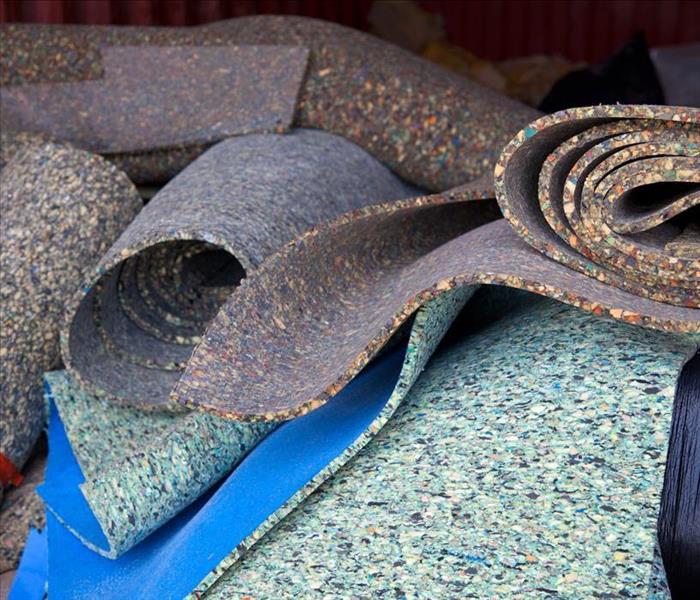 SERVPRO can restore or replace carpet padding after a water leak in a Manhasset home. We have the equipment.
SERVPRO can restore or replace carpet padding after a water leak in a Manhasset home. We have the equipment.
Entrust the Water Damage Restoration of your Manhasset Home to SERVPRO
Burst pipes and ceiling leaks can cause severe water damage in a Manhasset home, and it is not uncommon for homeowners to be unaware of the issue until it escalates. When water damage repairs are needed, relying on family and friends for help is not enough. Instead, call a professionally certified crew of experts to assess the situation and help establish a course of action and mitigate the damage.
In Manhasset, where water damage can happen due to weather factors and some homes' age, SERVPRO is ready to help. Close to Manhattan, many of the families who live in town take advantage of public transportation to commute to their jobs in the city. However, they get to enjoy the numerous green spaces available for leisure once they return home. Munsey Park, Shelter Rock, and North Hills all invite residents and visitors to enjoy the outdoors.
Not surprisingly, homeowners in Manhasset would rather spend their time in one of the town’s notable shopping areas instead of navigating the intricacies of water damage restoration.
Restoration can be achieved by calling SERVPRO and letting us take charge. Our staff is ready around the clock to meet your water clean-up needs by applying the latest best practices in our industry. When our fleet arrives, you can see for yourself that our equipment is suited for jobs of all sizes, including the extraction of water in large volumes as well as smaller amounts. Furthermore, the careful documentation we keep can be helpful when communicating with your insurance company.
Addressing Floors with Water Damage
It is not surprising that water settles on flooring materials whenever a pipe bursts or there is a leaking roof. Our first instinct may be to rent a heavy-duty wet-dry vacuum and extract any standing water. As sensible as this seems, extraction is not enough. At SERVPRO, we have specialized equipment such as drying mats, handheld extractor wands, and injecti-dry devices to restore your floors and carpet while maintaining a balanced humidity level. Some of the risks for your floors when there is excess moisture include-
- Delamination- when water causes the backing of your carpet to separate, that is called delamination. The latex that holds your flooring material's primary and secondary backing deteriorates significantly in water incidents, especially if it is of poor quality. Improper extraction or folding of the carpet can also cause delamination.
- Compromised Padding- padding may break when wet, making its replacement both necessary and cost-efficient. When our SERVPRO crew looks at the padding, we can make a recommendation based on our expertise. The average homeowner or repair person may not realize the extent of the issue because they lack the proper equipment to gauge the saturation level.
- Warping- tile floors may appear dry if the grout and joints were installed correctly. However, even a tiny crack in a tile or grouting may allow the subfloor to soak up water and eventually loosen up the tiles and joints. Our staff monitors moisture in the floor continuously to assess the drying process's progress and avoid complications.
SERVPRO of Great Neck/Port Washington provides much more than drying solutions. We leverage technology to restore your home, even the areas you did not think had been affected. Call us at (516) 767-9600 for a comprehensive assessment of your needs.
What Determines The Time It Takes To Complete Water Removal?
3/15/2021 (Permalink)
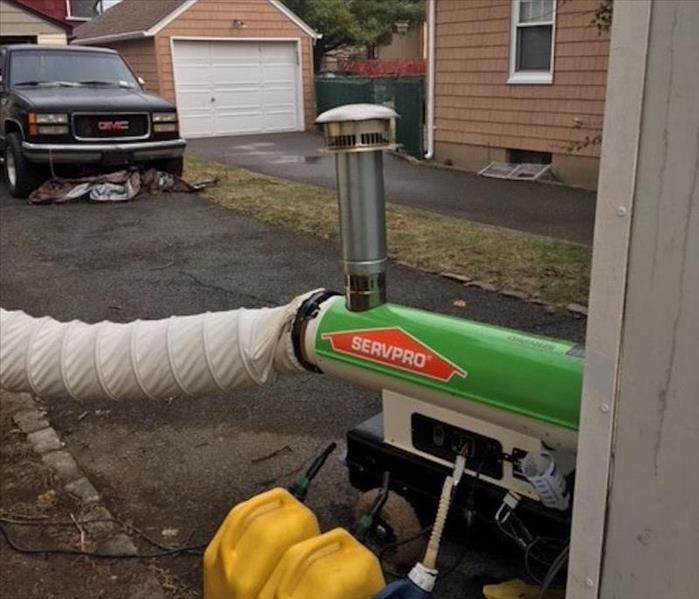 Water restoration to your property is a job for SERVPRO. They specialize in water restoration services of any size.
Water restoration to your property is a job for SERVPRO. They specialize in water restoration services of any size.
SERVPRO Makes Various Calculations to Estimate Timelines When Renovating Great Neck Properties
Before embarking on water removal from your property, you might want to know how long the processes involved are likely to take for reasons such as arranging alternative accommodation. Professional restorers can provide accurate estimates.
The time taken to complete water removal from Great Neck properties depends on the amount of water involved, the types of materials affected, and the resources used to manage the removal. Professionals derive an estimate by making calculations based on these aspects. Our SERVPRO technicians:
- Estimate the amount of moisture by checking room dimensions
- Calculate the setup of air movers and dehumidifiers
- Consider the drying system
Our SERVPRO IICRC certified technicians also help set the right drying goals because effective removal must be completed in good time to avoid secondary problems. For instance, if materials remain wet for over 48 hours, mold can develop, complicating the renovation. We can overcome such problems by using unique drying techniques, thus quickening drying. For instance, positioning air movers at a 45-degree angle against walls ensures that air bounces off the walls, thus moving moisture away faster.
SERVPRO of Great Neck / Port Washington optimizes water removal for faster results. Call us at (516) 767-9600 for assistance.
Manhassett Residents Prepare for Season's Festivities this Winter with the Nutcracker Ballet.
12/18/2020 (Permalink)
 It will be exciting to see the community enjoying the amazing performances this December!
It will be exciting to see the community enjoying the amazing performances this December!
Ballet Long Island is Putting Together a Festive Treat for Manhassett Residents for Two Nights this December.
As far as festive occasions go, the Nutcracker Ballet comes in high on any list. The magical experience created by Marius Petipa and enacted to a score from Tchaikovsky is reimagined this winter by Ballet Long Island. The two-night event takes place on the weekend of December 18th on Pond Road. Evening shows and Matinees are available for residents of Manhassett who want to enjoy this iconic Christmas-themed ballet. The ballet is suitable for all ages, with concessions available for senior citizens and kids. Tickets are booked in advance by calling (631) 737-1964 or through the box office of the Ballet Long Island building on Pond Road.
- The professional ballet company was founded in 1985 and continues to deliver affordable ballet for residents of Manhassett and broader Long Island.
- Arts in the education program are a core part of Ballet Long Island's mission statement, with apprentice and trainee programs available for aspiring dancers.
- Much of the income is through donations and membership, more details of which can be found on their site.
Controlling losses after water intrusion can help you to recover your home quicker with less expense. Contact SERVPRO of Great Neck / Port Washington at (516) 767-9600.
Why Is It Harmful to Allow Water to Evaporate Naturally?
10/30/2020 (Permalink)
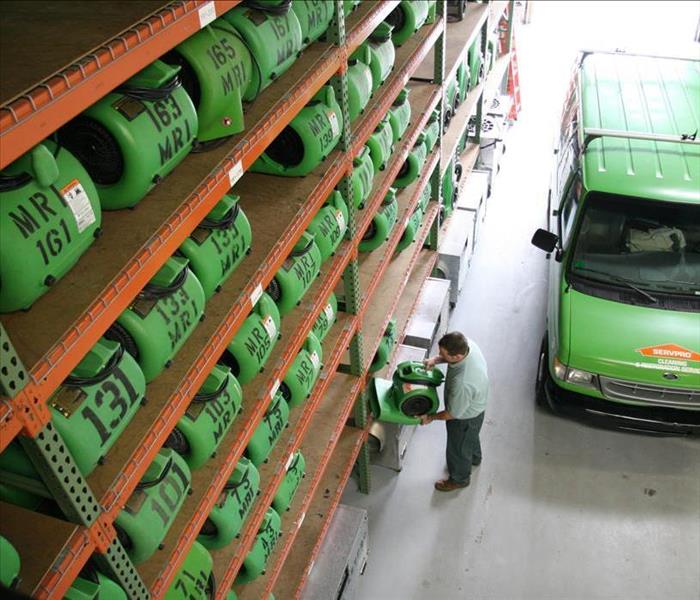 Call in the professionals for water cleanup, to avoid additional water loss in your home. Our SERVPRO technicians are available 24/7.
Call in the professionals for water cleanup, to avoid additional water loss in your home. Our SERVPRO technicians are available 24/7.
Quickly removing water damage helps reduce secondary damage.
This question is often asked by our clients in Manhasset, trying to decide if the water leaked onto floors and inside cupboards can just be allowed to dry naturally. Of course, they will mop up as much water as possible, but they cannot get into those difficult to reach areas, and soaked carpeting can take a week or more to dry on its own.
SERVPRO provides water mitigation services in Manhasset and surrounding areas. We also provide water restoration, fire, and storm cleanup and restoration services. Our team has been living and working in the area since 2007.
There are several reasons homeowners should plan to remove water and moisture as rapidly as possible. They include:
Mold infestations can begin to form within 24 to 48 hours of the initial water spill
Water penetrates particle board and pressed wood veneers causing permanent swelling and damage
Water also penetrates hardwood floors causing swelling and cupping of the hardwood planks
Carpets may delaminate, causing ripples, leading to trips and falls
We strongly recommend that all water, moisture, and humidity should be removed as soon as possible to mitigate further damage.
Why Does SERVPRO Use Dehumidifiers and Air Movers?
Our SERVPRO team evaluates every situation and implements a plan to remove the water and moisture from your home. Often we use vacuums to remove surface water, water extractors on carpets, and vacuum wands to reach difficult areas. However, there can remain a high amount of moisture in porous materials touched by the water. We use dehumidifiers and air movers to reduce the moisture levels further to dry the impacted area completely.
Dehumidifiers are placed in the room or rooms to dry the air
We position air movers to push dry air over damp materials and into cavities
Dry air absorbs moisture from carpeting, hard to reach areas, and from porous materials.
Call SERVPRO of Great Neck / Port Washington (516) 767-9600 for help with water mitigation and restoration of your home.
My Roslyn House Flooded After a Washing Machine Leak – Do I Need Professional Help?
9/12/2020 (Permalink)
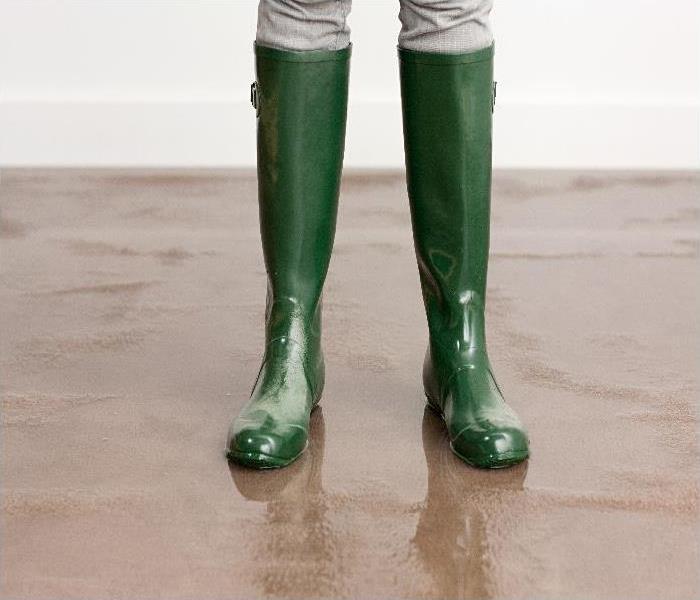 Contact SERVPRO of Great Neck / Port Washington at (516) 767-9600 for quality water cleanup restoration service.
Contact SERVPRO of Great Neck / Port Washington at (516) 767-9600 for quality water cleanup restoration service.
It is Best to Leave Water Damage Cleanup to the Professionals After a Major Water Intrusion in Your Roslyn Home
Residential flooding can be a result of many things. In this case, the washing machine developed a leak while the residents were out of the house. They came home to a flooded downstairs. It was time to call in a professional water restoration company in Roslyn.
Can I Clean It Up Myself?
It might seem like doing the water cleanup yourself in your Roslyn home would save you money. After all, you own a shop vac. There are plenty of YouTube videos and DIY pages that can provide all the information you need, right? It seems great, but the truth is that you need professional help. SERVPRO has expert technicians who are well-trained and understand what each situation calls for when it comes to water damage. There are several reasons not to attempt the water cleanup on your own but to leave it to a qualified company. These include:
• Insurance Company – For the damage and cleanup to be covered by your insurance company, they may require a professional assessment. They often want certified companies like SERVPRO involved in the restoration to back up claims.
• Safety – Safety first is crucial. Certified specialists know what to look for when it comes to safety issues involving water. It could include electrical concerns, contaminated water, or compromised structural components.
• Industrial Equipment – Your shop vac isn’t going to cut it. The cleanup process involved with household flooding needs industrial equipment beyond what the average homeowner possesses.
• Efficiency – Our teams come in, do a scope, and get to work. Immediate water mitigation is required. A homeowner cannot work as fast and as efficiently as a professional crew. This is a problem with DIY cleanup. It takes a long time, and the longer the water sits, the more comprehensive the secondary damage.
By hiring SERVPRO to mitigate the water damage, you save time and money. Speed is of the essence. You need that water removed from your home fast. We have the extraction equipment to pull gallons of water from your home quickly. We’re Faster to Any Size Disaster.
Should I Hire an IICRC Certified Company?
When you work with a business that has Institute of Inspection Cleaning and Restoration Certification (IICRC) certified technicians, you can trust the job to get done to industry standards. At SERVPRO, our technicians are not only IICRC certified but have extensive training in other areas as well. Our techs are qualified and have the experience to deal with emergency water mitigation, such as your washer flooding your living quarters. They are experts in the field of:
• Water extraction & cleanup
• Drying techniques
• Content management
• Restoration
What is the First Step Once I Call SERVPRO?
Once you make the call, our Green Team is on its way to you. We know how necessary it is to get your home back to normal. Our goal is as little disruption to your life as possible. A situation like this is stressful, and we relieve you of the stress of worrying about things getting done right. You can trust your home and everything in it to our crews.
In this home, the washing machine was in the hall across from the bathroom. This resulted in water flowing into the bathroom, living room, and a guest bedroom. Because the living room carpet soaked up a good bit of the moisture, it prevented the water from reaching the kitchen. When our team arrives at a water cleanup scene, they provide any emergency mitigation needed, such as locating the source of the water flow or making sure there are no electrical issues.
What Happens Next?
The technicians perform a scope to ascertain what needs addressing in your specific circumstances. Not every job requires the same procedure. They then work on extracting the water from carpets, floors, and walls. Powerful truck-mounted pumps may get used. We also have portable pumps and industrial strength water vacs. Moisture sensors and infrared cameras are used to look for hidden moisture. We then move on to drying out the impacted areas. Industrial strength air movers, fans, and dehumidifiers are put to use in the correct ratio to dry your home as quickly as possible. Water intrusion can leave bad odors, and deodorizing is part of the water cleanup if necessary. We use EPA approved cleaning products to sanitize all surfaces.
What About My Furniture and Other Things?
If the content can be cleaned on-site, we do that. If it isn’t possible to clean the items on-site, we provide pack-out services. The content gets moved to our warehouse for cleaning. Depending on the extent of the flooding and water damage involved, we can restore:
• Flooring and carpeting
• Wood items and furniture
• Upholstered items
• Linens, drapes, and clothing
• Household goods
• Books, papers, and documents
SERVPRO puts everything into restoring your home and returning it to you, “Like it never even happened.” We are available 24/7 because we know disaster does not wait for a convenient time. If your home has experienced flooding, we have experienced IICRC certified professionals to provide the water cleanup mitigation necessary.
Contact SERVPRO of Great Neck / Port Washington at (516) 767-9600 for quality water cleanup restoration service.
A Water Intrusion Incident Has Happened in My Property. How do I Restore the Affected Areas?
7/21/2020 (Permalink)
 SERVPRO professionals are trained to handle all types of water damage.
SERVPRO professionals are trained to handle all types of water damage.
Call SERVPRO’s Team of Technicians to Provide Water Damage Restoration in Your Manhasset Property.
After a water intrusion incident, restoring a property to its pre-damage state often involves water removal, decontamination, drying, and odor removal. It is vital to act fast by working with reliable restoration experts in Manhasset, like SERVPRO technicians.
Why should I act fast?
Performing water damage restoration in your Manhasset home as soon as you can is critical. The sitting water and moisture can create a perfect environment for bacteria and mold growth. Some parts of the affected property may require to be rebuilt. Valuable materials such as carpet and pad, as well as drywall that have absorbed water, can get damaged beyond repair. By contacting professionals immediately after the incident, you can avoid these costly repairs.
How do you restore homes?
We repair and restore water-damaged properties to return them to their normal condition. Our restorers usually complete water damage mitigation before water damage restoration. The goal of water damage mitigation is to prevent further water damage from affecting the structures and contents of a building. Some of the things we can do during the water damage mitigation process include:
Removing ruined materials like flooring and drywall as well as furniture from the affected areas.
Cleaning and disinfecting salvageable items.
Extracting water using pumps.
Drying the home using air movers and dehumidifiers.
After the water damage mitigation process, our technicians concentrate on reconstructing or rebuilding a home through a variety of applications. The goal of the water damage restoration process is to help you recover from all damage. The steps we can take to restore your home largely depend on the severity of the water loss. Some typical water damage restoration services include:
Eradicating mold.
Replacing ruined flooring and walls.
Conducting moisture and humidity testing to ensure all issues are resolved.
How do you dry the affected areas?
Using our advanced equipment, we can take the shortest time possible to dry the affected areas. Our SERVPRO technicians can use several air movers to speed up the drying process. At times, we use portable heaters to increase the temperature in a home. Drying takes place faster when a room is heated better 70 to 90 degrees Fahrenheit because hot air holds more moisture. Our team uses dehumidifiers to remove moisture.
What about the odor in my property?
Odors can make a property inhabitable. Odors may persist depending on the intensity of the water damage. Our technicians can use air filtration devices to remove odors. These devices contain HEPA filters that can remove the airborne particles from the air, leaving your property feeling and smelling fresh.
Water damage can leave you and your family devastated. Contact SERVPRO of Great Neck / Port Washington at (516) 767-9600 for effective restoration services.
See more about Manhasset.
How Can You Take Water Out of Hardwood Flooring?
5/20/2020 (Permalink)
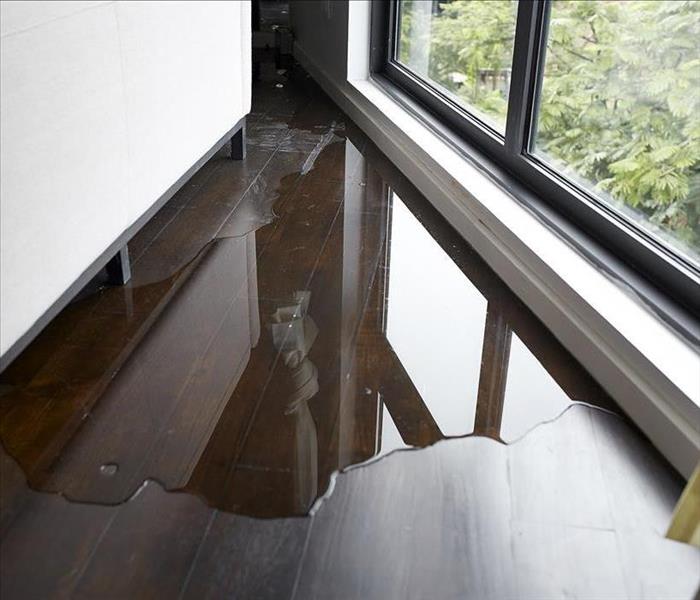 Don't let your flooring become a disaster from the water damage in your Great Neck home. Call SERVPRO to mitigate your water issue.
Don't let your flooring become a disaster from the water damage in your Great Neck home. Call SERVPRO to mitigate your water issue.
Wood planks can absorb water quickly, so our SERVPRO team can recover these materials with effective drying solutions.
The absorption rates of wood flooring vary on the type of wood used to cover the floors of your Great Neck home and the finish on these surfaces. Certain coatings can make planks less sensitive to absorption, but eventually, water penetrates natural hardwoods.
Removing water in your Great Neck home once it penetrates the surface of wood flooring can exceed the capabilities of drying practices.Homeowners can perform on their own. Our team has multiple strategies for removing moisture trapped in planks, and these include floor mat drying systems and centrifugal air movers.
Why Is Wood So Sensitive to Moisture?
Cellulose in natural woods absorbs surface moisture. While our SERVPRO team can address this phenomenon in earlier stages, once water chemically bonds with the wood, the damage is often too severe to restore. There are three primary stages of water exposure to wood:
- Water stays on the surface
- Water penetrates wood planks but has not bonded
- Moisture alters the appearance of the wood floors
Saturated wood flooring can be costly to replace, but our SERVPRO of Great Neck / Port Washington team has effective water removal tactics to help. Give us a call at (516) 767-9600.
We Act Fast In Great Neck After A Water Loss
4/1/2020 (Permalink)
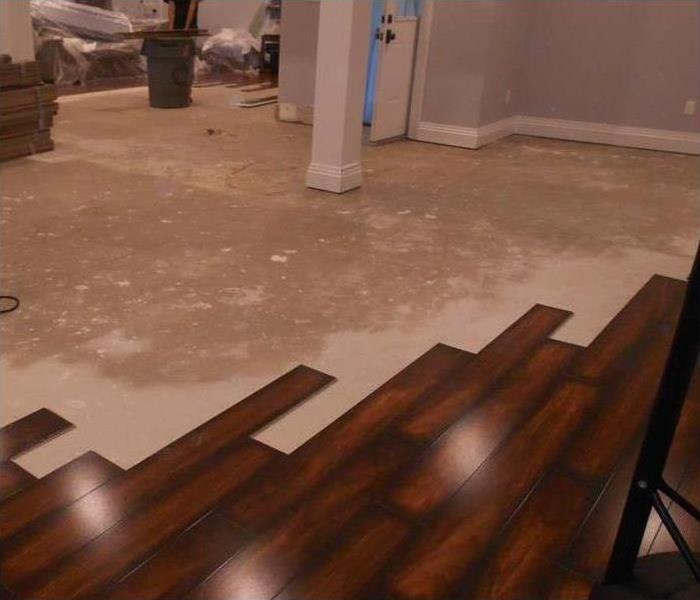 We pulled up the laminate to get the moisture out quickly and avoid any additional damage or mold growth in this home.
We pulled up the laminate to get the moisture out quickly and avoid any additional damage or mold growth in this home.
Prompt Action Can Save the Wood Flooring in Your Great Neck Home After Water Damage
Whenever you have beautiful hardwood flooring in your home, any water loss event calls for immediate response to help lessen the damage. Whether the water originates from a broken pipe under your kitchen sink or a faulty appliance, our team at SERVPRO knows how to address the problem promptly. The faster that you call us to assess the damage and get started on the cleanup, the easier it is for us to make it “Like it never even happened.”
Water damage in Great Neck is something that we are well-versed in at SERVPRO. With a quick response and professional methods for cleaning and restoring your interior, we can salvage your wood flooring. We put a plan of action in place that allows us to control things like the temperature, humidity, and airflow throughout your home to keep the flooring from warping while inhibiting mold and mildew growth.
Extraction
Upon arrival at your home, our skilled technicians assess the water damage and any of the remaining surface water. We extract water from the surface of your hardwood floors, using portable extractors with wand attachments that allow us to reach tighter spaces. Any moisture that remains on the surface after this step evaporates with the help of dry, warm air flowing throughout the space.
Addressing Water Under the Surface
If there is free water that has not yet bonded with the molecules of your wood flooring, we then take care of removing it. While free water is a bit more challenging to remove, our SERVPRO technicians utilize air movers that help create beneficial airflow that glides over the wet floors. Our team uses a unique formula to decide the right temperature and humidity ratio so that we have the ultimate combination of airflow and dehumidification.
For bound water that has been absorbed into your hardwood flooring and fully bonded with the molecules of the wood, we apply heat with the help of portable heaters. Drying mats strategically placed on the floor helps to create strong suction that pulls up water that is then released either as water or vapor. Once fully dry, our SERVPRO team thoroughly cleans and disinfects the space to inhibit mold growth and the onset of foul odors.
Do you need help with addressing water damage to your hardwood flooring? Call our team at SERVPRO of Great Neck/Port Washington at (516) 767-9600, and we will send out a team as quickly as possible for an assessment of your needs.
See more about Great Neck.
How SERVPRO Removes Water From Great Neck Homes
2/11/2020 (Permalink)
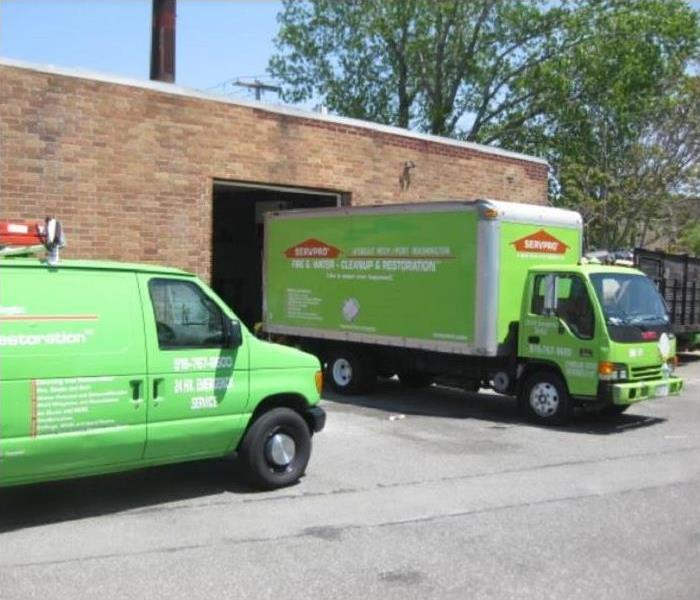 Day or night, SERVPRO is always on call to handle your water damage emergencies!
Day or night, SERVPRO is always on call to handle your water damage emergencies!
Expediting Water Removal from an Affected Great Neck Property
When you discover a water spill in your property, there is no time to waste. Starting the removal process immediately and completing it fast helps in many ways, including making the property habitable again and reducing the percentage of secondary damages that develop. SERVPRO helps expedite water removal in many ways.
The quickest way to address water removal from affected Great Neck properties is to extract it before it soaks into materials around the property. Removal of surface water requires the right pump, which can provide the right lift and volume capacity. It should also be convenient to handle, especially if different parts of the property are affected. Our SERVPRO teams have access to a wide variety of extraction equipment, including submersible pumps, truck-mounted extractors, portable extractors, and dry wet vacs, among others. Therefore, we can choose the most appropriate for your property.
After removing all surface water, there is a need to address any moisture left in contents or building materials fast. Dehumidifiers help with such removal. They work by pulling water vapor from the air, thus increasing the evaporation from wet materials. Our SERVPRO technicians expedite the process by choosing high-efficiency dehumidifiers such as the low grain variety, especially in the final stages of drying when other types are less efficient. We also modify conditions at the loss site by increasing air movements and temperature to improve efficiency. Increasing air movements also increase the evaporation rate while higher temperatures help the air hold more moisture expediting the removal process.
Sometimes convenient water removal is hampered by contents, which obstructs the movement of restoration crews or prevents proper usage of removal equipment. Our SERVPRO crews perform partial or complete move-outs creating the necessary room for fast water removal. For partial move-outs, we identify a dry location within the same building to act as temporary storage for your contents.
One way to reduce damages caused by water loss incidents is to complete the removal process fast. Call SERVPRO of Great Neck / Port Washington at (516) 767-9600 to help. We're Faster To Any Size Disaster.
More about Great Neck.
Extreme Water Damage
6/21/2019 (Permalink)
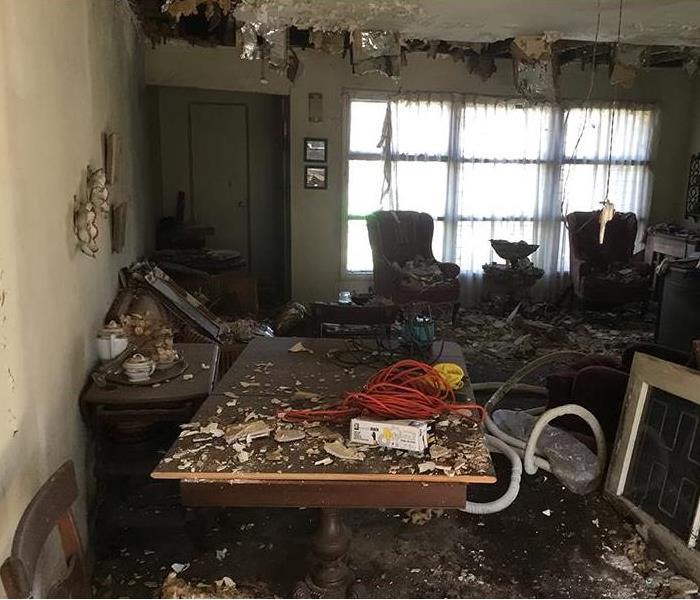 Extreme Water Damage
Extreme Water Damage
Water damage can be minor, major and catastrophic. It seeps into areas you can't see or reach, and it destroys materials and possessions in it's path. At SERVPRO of Great Neck/Port Washington, we've seen all degrees.
Here, we'll walk you through a major case. Water pouring from above has collapsed ceilings, you'll see insulation and ceiling drywall covering rooms. Buckled walls and hardwood floors, caused microbial growth (mold) to take root. Books, photos, art and chairs, couches and carpeting are destroyed, wood furniture begins to swell and veneers pop, finishes get cloudy and delaminate. Electrical wiring in the ceiling and walls are compromised. This is now not a livable space.
SERVPRO will come in and removed all of the damaged materials and strip the spaces so contractor ready to refurbish - after intensive drying, cleaning, moisture reduction and mold prevention measures are taken.
Black Sewage Contaminated Water Damage Must Have Proper Restoration
6/23/2018 (Permalink)
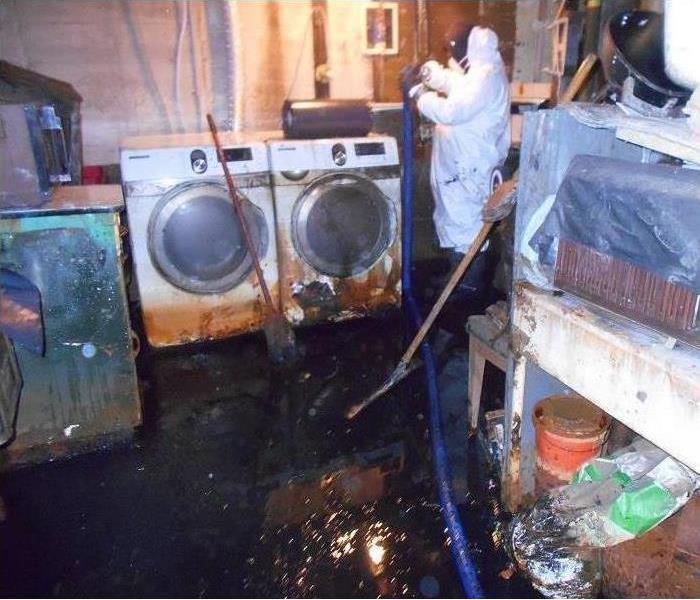 Hoarding situations and sewage/black water losses can be restored
Hoarding situations and sewage/black water losses can be restored
This job came to us in the fall and is one of the more extreme and tragic cases we have experienced. The elderly homeowner frail was a hoarder suffering mental health issues.
Months earlier the sewage line had blown, flooding a packed basement with raw sewage, swimming in pathogens.
Due to the homeowner's frail condition and distress about the situation, they closed the door and ignored it. Delays cause even greater damage but in our line of work this is a situation that we've experienced more often than you'd imagine.
The sewage line was not fixed during this time, the wet contaminated water and solids permeated all porous surfaces and caused damage to non-porous surfaced, just from exposure. You can see the effects to the washer and dryer.
In this situation, the contents become a hazard and must be carefully removed and discarded because of microbial and mold growth. Extensive antimicrobial were used in cleaning, and air scrubbers placed to ensure that the structure was clean and safe once more.
Restoration After Utility Water Damage
6/23/2018 (Permalink)
 This utility area suffered water damage after the equipment failed.
This utility area suffered water damage after the equipment failed.
When boilers/hot water heaters blow, it can create quite an unexpected mess through the surrounding areas. Often, we find that homeowners have accumulated content on the floor, often papers, photos, clothing and toys in cardboard boxes - which get saturated as it wicks in the moisture.
For precious or vital papers that must be saved, SERVPRO has the ability to dry them out through a special freeze-drying technique at one of our out of state facilities. After packaging them up we send them off. While they may not appear perfect as before, the moisture is completely removed, and the documents can be kept or scanned. Preventing mold growth through boxes of papers and photos will avoid mold growth down the road.
Ask your local SERVPRO professional about document restoration after water damage!
SERVPRO of Great Neck/Port Washington is Ready to Resolve Any Water Damage Situation
6/7/2018 (Permalink)
 Photo of a flooded basement in Long Island, NY.
Photo of a flooded basement in Long Island, NY.
Water damage to your residence can appear in a many forms, in a multitude of ways. Not all water emergencies require extraction but, in this situation, this finished basement living room area was flooded with water which was caused by an over flooded toilet.
Regardless of the severity of the damages SERVPRO of Great Neck/Port Washington is ready to handle even the most difficult of tasks, our SERVPRO technicians will ensure that every effect of the water incident will be resolved accordingly.
Overcoming water damage in your home residence or property is concerning and will require professionalism and expertise that our SERVPRO of Great Neck/Port Washington technicians have, count on us if you ever in need of our services. Call us at (516)767-9600.
Most Commonly Used Drying Equipment With Water Damage Restoration
5/23/2018 (Permalink)
 Air movers - affectionately called snails!
Air movers - affectionately called snails!
Commonly used equipment includes:
- Air Movers: Used to accelerate air flow and evaporation of moisture from materials for restorative drying.
- Dehumidifiers: Used to reduce moisture levels, accelerate the drying process in water restoration
- Floor Drying System: These are high-pressure air mover mats, used during water restoration to dry hardwood floors. This system draws evaporated moisture out of damages areas and creates a vacuum seal on mats to move air from the subfloor to the surface.
- Air Scrubbers: used for cleaning and controlling air quality in restorations.
- Hygrometers: Moisture meters used to detect or monitor moisture in most building materials.
- Submersible pumps: drains standing water from any surface - ideal for flooded basements, farm use, draining standing water from swimming pools, fountains, flooded basements, etc.
- Extractors: usually used for water extraction from carpet and hard surfaces.
A successfully water damage restoration always begins once the standing water has been removed - though it may not be visible in puddles. Nevertheless, there are specific methods used for each and every situation.
Above Average Precipitation For Winter 2017-2018 Can Cause Water Damage
11/17/2017 (Permalink)
 snowy winter predicted
snowy winter predicted
The Farmers' Almanac has long been what people look to forecast what the upcoming seasons will look like - we at SERVPRO of Great Neck/Port Washington always review what the Farmers' Almanac predictions are so that we have an idea of what lies ahead.
Recently they released their long range predictions for the coming winter season. For our area here on Long Island, New York we will experience above normal precipitation with a "cold and snowy" season. We can expect a good amount of snow along with cold temperatures, which can lead to ice damming, roof leaks, backed up gutters, and basement leaks.
The Farmers' Almanac has said they are also "red-flagging the 2018 dates of January 20-23, February 4-7 & 16-19, and March 1-3 & 20-23 along the Atlantic Seaboard for some heavy precipitation."
With a cold winter on the horizon, take measures to winterize and prepare now.
Snow and Ice Dams on Your Roof
11/17/2017 (Permalink)
 Ice dams on roof
Ice dams on roof
Ice dams are common in our region. Sometimes they are caused by blocked gutters and spouts and often on the roof. The heat in your attic melts the underside of snow that has accumulated on the roof. That water trickles to the eaves where it freezes and grows into a larger and larger ice mound. Water can work it's way inside your roof and attic creating a lot of damage before it is discovered, often resulting in secondary mold damage.
How to deal with an ice dam? knock off what you safely can with a broom or shovel. While not recommended to use rock salt on your roof (it causes structural and material damage), calcium choloride is an option - your local home improvement retailer should have several options for you that will allow you to easily create a channel for water to run off the roof.
If water has made it's way into your attic, SERVPRO of Great Neck/Port Washington is here to help!
Water Damage in Hospitals, Medical and Healthcare Facilities
1/19/2017 (Permalink)
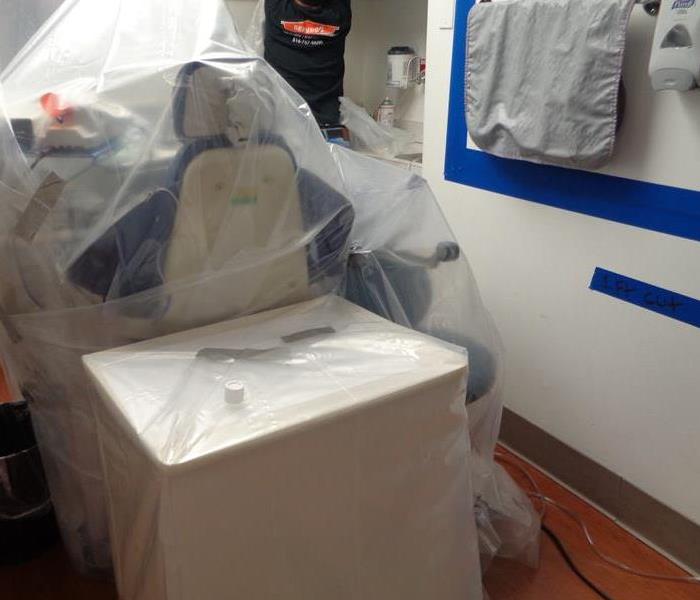 Water Damage in Hospitals, Medical and Healthcare Facilities
Water Damage in Hospitals, Medical and Healthcare Facilities
Water events at Long Island and NYC facilities are of great concern when you have tens and hundreds of thousands of dollars worth of sensitive medical equipment and critical documents. Unfortunately, we've seen a lot get damaged in Nassau County, Suffolk County, Brooklyn, Queens and New York City that was avoidable.
This healthcare facility had extensive water damage and unfortunately many pieces of electronic diagnostic and treatment tools as well as computers were in the line of fire.
These are the best ways to proactively protect your equipment from water damage:
- Make sure you know where overhead pipes are located if you have drop ceilings this is helpful - and if possible, keep equipment on the opposite side of the room
- If units in your building are vacant and freezing temperatures are coming , DO make sure the building's facility management has the heat turned on in those units - a pipe break from a freeze at the other end of the building can affect your unit if their pipes cross through your unit. If you are on a slab, this happens.
- If equipment has no choice but to be located underneath pipes, use water catch systems that are designed to hide up in the drop ceiling and divert water away
- Emergency water diversion systems can also be installed outside of the ceiling - helpful when you don't have a drop ceiling but do have a leak - though they are visible. These are not ideal for permanent placement and are not pretty, but they help keep your equipment and documents dry when you can't move everything and water is flowing where you don't want it. These are used frequently in warehouses with known leaks.
Can my belongings survive a water damage?
1/19/2017 (Permalink)
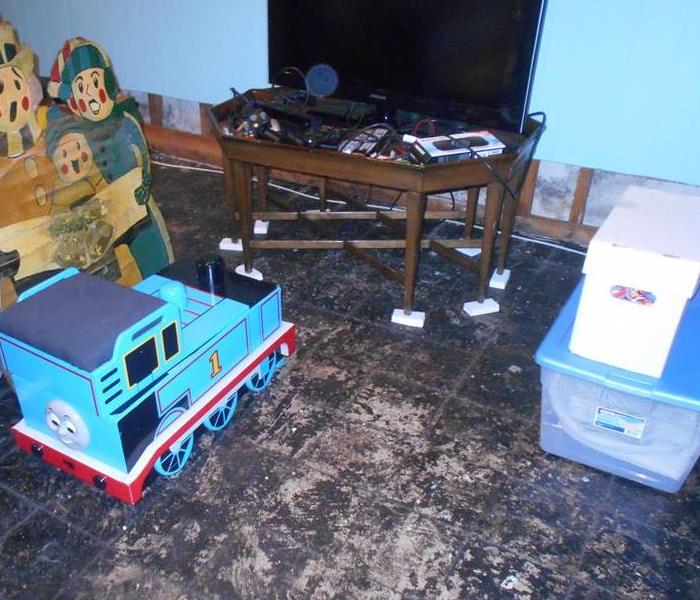 Water damage
Water damage
House floods on Long Island can happen from natural environmental or weather conditions or mechanical failure - but either way, your stuff ends up soaked. What happens next?
At SERVPRO of Great Neck/Port Washington, we know you have irreplaceable mementos and family pieces as well as furnishings, photos and important documents that you need to keep and maintain. If you haven't protected them by storing in watertight plastic containers, we will do our best to salvage and restore your contents.
With a lot of clear and grey water damage a lot of your contents might be salvageable.
If bio hazard contamination is in play - be it from medical waste issues, crime scenes, infectious disease or raw sewage exposure it is generally necessary for us to rapidly discard those items for your safety - especially if they are paper, fabric or of other porous material that cannot be adequately cleaned and sterilized.
Small numbers of documents that are needed but damaged are best captured by photo then discarded. we do have the ability to dry large amounts of clear and grey water damaged documents, books and photos in huge drying chambers through our corporate facility. They will appear water damaged, no longer perfect - but will be dry.
SERVPRO of Great Neck/Port Washington Cleans Up Water
11/15/2016 (Permalink)
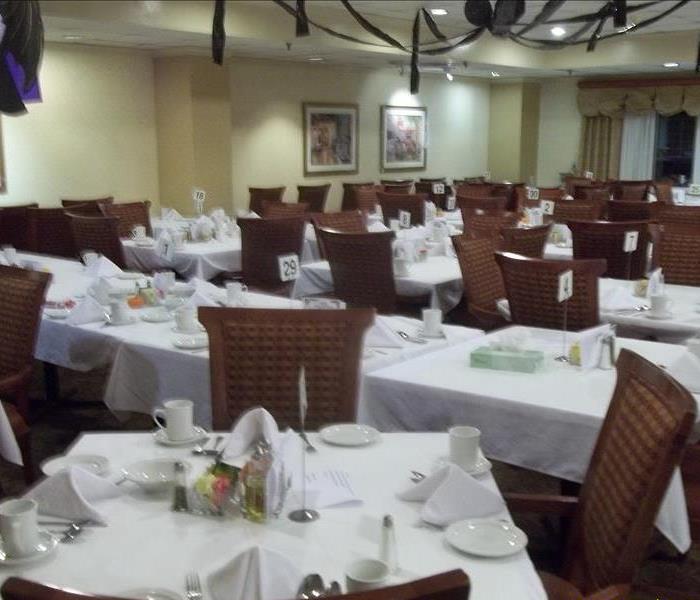 The Assisted Living facility's dining room is back up and running.
The Assisted Living facility's dining room is back up and running.
SERVPRO of Great Neck/Port Washington gets calls 24/7 - and we respond quickly. One such call was an Assisted Living Facility that had been undergoing extensive roof reconstruction. The weekend was approaching and the out of state contractor needed to keep the dining room dry as untimely rainstorms had caused a small puddling. Fortunately he had secured our company at the first sign of trouble. When consecutive storms created a dramatically bigger problem in a very short while later flooding the dining room and creating damage to the ceiling and walls, we were able to get there and manage the problem, drying out the room so that the residents could use the room and the contractor was able to finish off the roof construction so that no further water entered the structure.
It's The Water That You Don't See That Is The Danger
8/26/2016 (Permalink)
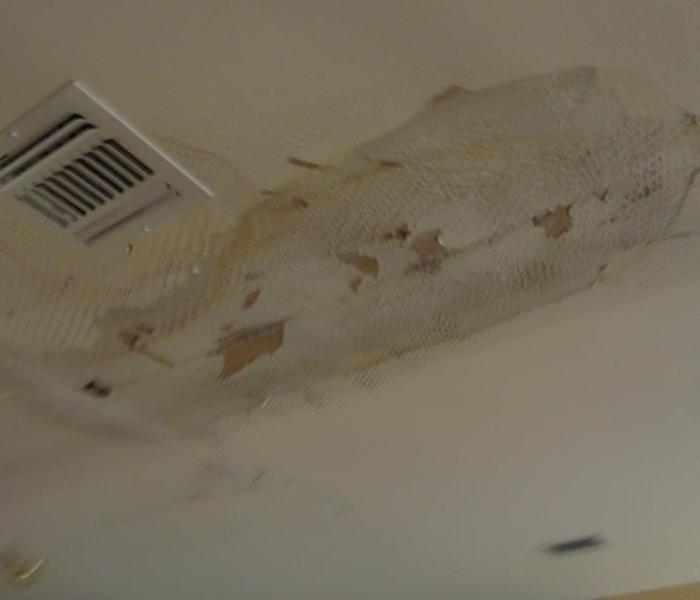 Long Island, NY water damage - ceiling leaks can cause tremendous damage if ignored.
Long Island, NY water damage - ceiling leaks can cause tremendous damage if ignored.
The key to avoiding a costly restoration is to eliminate water issues before they become a threat. Time and timeliness matters. A simple fix that goes unattended may progress to an out of control problem that could result in tens of thousands of dollars of losses to your home or business or even create hazards.
SERVPRO of Great Neck/Port Washington professionals have the training, experience and equipment to mitigate any water situation. If water issues go on for too long particularly inside of walls, secondary damages can become problem if mold has begun to grow.
Take care of small leaks as soon as detected.
Call our SERVPRO team to rapidly dry & disinfect your structure.
Warped wet wood floors? We have a remedy for that!
Mold is a health hazard - SERVPRO teams are highly trained in re
Residual odors? We have various ways of removing odors created by a variety of sources.
Allow SERVPRO of Great Neck/Port Washington to help with your water situation.
U.S. East Coast Cities Face Frequent Flooding Due to Climate Change
10/13/2014 (Permalink)
Cities on America’s East Coast could see triple the number of tidal floods by 2030 as sea levels rise.
Dozens of America’s East Coast cities face increasingly routine tidal flooding under climate change, researchers said on Wednesday.
Miami—where the denizens of South Beach are used to sloshing through water at high tide—will deploy new pumps this week to hold back the waters of the King Tides, the highest annual high tides, which are projected to crest at 3.5 feet.
Other cities are going to have to undertake similar measures if they want to avoid soggy streets in the future, the researchers said.
The report, Encroaching Tides: How Sea Level Rise and Tidal Flooding Threaten U.S. East and Gulf Coast Communities over the Next 30 Years, from the Union of Concerned Scientists (UCS), found that most of the towns on America’s East Coast will see triple the number of flooding events by 2030.
By 2045, those towns will see 10 times as many tidal floods—and those floods will seep further inland and last longer, the researchers said.
Many coastal towns already see dozens of small tidal floods every year, typically lasting only a few hours. But the frequency of such events is marching upwards because of sea-level rise, which at some points along the East Coast is more than twice the global average. Some East Coast towns have recorded four times as many flood days as in 1970, the report found.
Washington, D.C., which already experiences flooding from the Potomac river during hurricanes, will see chronic flooding—with 388 occurrences a year by 2045, according to the report.
Annapolis, Maryland; Lewisetta, Virginia; and Wilmington, North Carolina, will see more than 300 tidal floods a year. Miami—which now experiences about six tidal floods a year—will also get wetter.
“Further down the coast, Miami Beach, in 30 years, would experience more than 200 tidal floods a year,” said Erika Spanger-Siegfried, a UCS analyst and co-author of the report. “ Some could affect much of the art-deco historic district of South Beach ... Without serious intervention, frequent flooding will start to disrupt daily life and change the way an area functions.”
The researchers used National Weather Service flood advisories and records from 52 tide gauges in coastal towns from Portland, Maine, to Freeport, Texas, to make their projections.
In nearly all of the towns, tidal floods will be a regular occurrence, they found. By 2030, most of the towns could expect to see flooding in some areas 24 times a year. Some of those towns would see 48 floods a year.
The frequency of those floods will worsen over time, the researchers said. By 2045, half of the towns can expect to see more than 100 tidal floods a year. Nine of those towns would see tidal floods 240 times a year by 2045.
Those cities can also expect to spend more time underwater. By 2045, flood-prone areas of Wilmington, North Carolina, will spend more than 345 hours a year underwater. Baltimore’s Inner Harbor is projected to be underwater for more than 875 hours a year by 2045.
And the floods are also expected to worsen—with deeper waters penetrating further inland and threatening more property, the researchers found.
Flood Safety and Preparedness
10/1/2014 (Permalink)
Flash flooding is a possibility in all 50 states, although people living in flood plains and by rivers or shoreline are uniquely vulnerable to regular flooding. While you may have time to prepare for flooding that builds slowly – such as a river overflowing its banks – flash floods can occur very quickly, and every year, flash flooding is responsible for more deaths than tornadoes, hurricanes or lightning. Here’s what to do before, during and after a flood.
Know emergency flood terms
- Flood watch: Flooding is possible.
- Flash flood watch: Flash flooding is possible.
- Flood warning: Flooding is happening now, or will soon.
Flash flood warning: A flash flood is occurring; seek higher ground (on foot) Making a plan
- An emergency kit is something everyone should have on hand, no matter your locale or the natural disasters your area is vulnerable to. The Federal Emergency Management Agency's Ready.gov can help you build one — with food, water, and essential supplies for 72 hours — fairly easily, as well as teach you where to store it and how to update it. If the idea of making your own kit is too daunting, you can buy an emergency preparedness kit put together by the American Red Cross.
- Plan an evacuation route with your family, and perform regular drills.
- Buy and install sump pumps with back-up power.
- Raise electrical switches, sockets, circuit breakers and wiring at least 12 inches above the highest projected flood elevation for your house.
- Install backflow valves or plugs in drains, toilets and other sewer connections, to keep floodwaters from entering.
- Fuel tanks, if torn free by flood water, can leak contaminants or cause other damage if swept downstream. Make sure fuel tanks are anchored.
If there’s a flood or flash flood watch
- Gather emergency supplies and tune into local media or the NOAA Weather Radio for updates.
- Review emergency plans with the household.
- Fill car with gas and place emergency kit inside car, or make arrangements with others for a ride
- Sanitize sinks and tubs, then fill with clean water. Fill plastic soda bottles and other containers with clean water.
- Bring lawn furniture, trash cans, grills and play equipment inside, or tie down outside.
- Gather medical records, identification cards, insurance cards and other documents, and place inside a waterproof container for transport during evacuation.
- Take livestock and family pets to a safe area (emergency shelters do not accept animals).
- Adjust refrigerator and freezer to the coldest possible temperature in case you lose power for an extended period.
If evacuation is ordered
- Never ignore an evacuation order.
- Take only essentials.
- Turn off utilities at the main power switch, and shut off the gas. Turn off electrical appliances.
- Don’t try to walk through flowing water, as even 6 inches of moving water can knock you down and drowning is the number-one cause of flood deaths.
Driving in a flood
- Don’t drive through a flooded area. You won’t always be able to tell how deep water is. Six inches of water is enough to cause stalling or loss of control. Many vehicles will float in just one foot of water, and two feet of water is enough to carry most vehicles away.
- Don’t drive around a barricade.
- Stick to evacuation routes, and don’t take short cuts.
- If you’re driving at night, be especially cautious.
Weather the storm
- If you aren’t ordered to evacuate, stay tuned to local media for weather updates.
- Even if you are instructed to stay at home, be prepared to evacuate if your house is damaged, of if you receive orders to do so.
When you return home
- Turn off your electricity when you return home.
- Watch for animals and snakes that have been washed out during the flood.
- Look for hazards before you step – flood debris can be dangerous.
- Check for gas leaks before lighting candles or using any open flame.
- Clean everything – including yourself – that has gotten wet. You don’t know what chemicals and other hazards are in the flood water.
- If your power has gone out, never use a generator indoors, because deadly levels of carbon monoxide can build up quickly in small spaces and remain dangerous for hours.
Protecting Your Property From the Threat of Spring Flooding
5/5/2014 (Permalink)
Reprinted from the Spring 2014 CAI - LI Chapter Newletter
By Deborah Rashti, VP of Marketing for SERVPRO of GN/PW
This was some winter! And the deluge of water that fell from the sky the last day of April was another example of Mother Nature’s wrath. While we count on spring showers to bring us May flowers, we do not take too easily to the flash flooding that sometimes accompanies it. Last month’s mudslide in Washington State that smothered almost an entire community is one of many examples of how dangerous spring flooding can be.
When rainwater overpowers drainage systems, basements are easily susceptible to flooding. Being proactive about keeping our gutter systems clear of debris is one of the simplest ways to minimize this possibility. Depending upon the surrounding landscape, you may need to do this more than a couple of times a year.
Unbenownst to most people, flushing gutters with hose water after removing leaves is a necessary step to make sure debris is completely removed. Since gutters need to hold a tremendous amount of water during heavy rains, the best time to see if they are working properly is 15 minutes after the downpour while it is still raining.
Overflowing gutters near a home’s foundation is not a good thing. While it may not necessarily cause flooding in a basement, this overflow can cause erosion around your foundation that could lead to cracking of walls and ceilings. Adding an additional spout or expanding the width of the spout can easily solve this.
While most of us do not like the esthetics of a spout that extends 10 feet from our home, it really is an excellent way to keep water away. Depressions of soil around the foundation of our home can be a red flag that there is a water problem. Catching this early can make a huge difference in the money you’ll save from avoiding a cleanup from flooding.
Don’t discount the risk of flooding coming from your sprinklers either. Not only do we not want sprinkler heads pointed at our home, but we also do not need more water after a significant rain. Adding more water to an already saturated property is opening yourself up to potential problems. Rain gauges serve an important purpose for our sprinkler systems and having them checked annually is in our best interest.
In the event that water is penetrating our basement from a source that lies below ground level, you will need an experienced waterproofer who has an excellent reputation. This is a tricky problem as hydrostatic pressure can push water through hairline cracks for a multitude of reasons. You need a good diagnostician to identify why the water is coming in and what is needed to correct the problem. Don’t even think about putting your basement back together BEFORE this is worked out.
As with anything, proper maintenance is key to minimizing costly repairs later on. As opposed to pipe breaks, basement’s flooded by rainwater is generally NOT covered by homeowners insurance. The amount of money involved in getting your basement back to pre-existing condition can be costly. Simple steps to maintain your home may require a commitment on your part, but may save you money in the end.
While it is hard to embrace our potential for flooding, keep in mind that much of the country is experiencing severe drought conditions and brush fires are a very real threat to their community. With careful planning, we can mitigate the potential loss of flooding due to heavy rains. Enjoy those spring flowers that we have waited so long to see.
Flood Awareness: Preparing Homes and Businesses For Spring Flooding Season
5/2/2014 (Permalink)
With spring flooding season here, the Property Casualty Insurers Association of America (PCI) is encouraging property and business owners, as well as renters, to prepare for flooding.
“There are many things property owners and renters can do to safeguard their homes, businesses and personal property before spring flooding hits,” said Chris Hackett, PCI’s director, personal lines policy. “Floods are the most common natural disaster in the nation and can be extremely devastating not only to property, but to a household’s finances if proper precautions are not taken. However, with some simple actions such as talking with your insurance agent or company about your insurance coverage options you can be better prepared if a flood occurs.”
First and foremost, PCI urges property owners and renters who do not already have flood insurance to purchase a policy from the National Flood Insurance Program (NFIP) as soon as possible. Basic homeowners and renters policies do not cover flooding. Consult an insurance agent or go to the NFIP website at www.floodsmart.com to find out about purchasing a policy. Understand that there is a 30-day wait upon purchasing a flood policy, so it is important to act before a flood is imminent.
Second, for those who already have flood coverage, policyholders should be sure to review their policies and what they cover, and discuss their coverage with their agents. It is important to keep the agent’s name and contact information in a safe and easily accessible place, and to take an inventory of all personal property. Photograph or videotape items for verification and keep the photos or video footage, as well as finance records or receipts of major purchases, in a safe place, such as a safety deposit box.
The NFIP’s website also recommends the following actions to prepare a home for possible flooding:
- Make sure if there is a sump pump that it is working and install a battery-operated backup.
- Install a water alarm in the basement.
- Clean gutters and downspouts to remove any debris.
- Anchor any fuel tanks.
- Raise electrical switches, sockets, circuit breakers, and wiring at least one foot above the home's projected flood elevation.
- If possible, place appliances such as a furnace, water heater, washer, and dryer on cement blocks at least one foot above the projected flood elevation.
Additionally, the NFIP’s website recommends developing a family emergency plan and a safety kit with basic components such as drinking water, canned food, first aid, blankets, a radio, and a flashlight. Components of emergency planning include posting emergency telephone numbers by the phone; teaching children how to dial 911; planning and practicing an evacuation route with family members; asking an out-of-state relative or friend to be an emergency contact; and preparing a safety plan for any family pets.
“With the proper preparation, property owners and renters can safeguard their families and property, reduce potential damages, and also speed up the recovery process,” Hackett said. “We ask all people who might face spring flooding to take these simple steps starting now, so they can be ready when the time comes.”
PCI is composed of more than 1,000 member companies, representing the broadest cross-section of insurers of any national trade association. PCI members write over $190 billion in annual premium, 40 percent of the nation’s property casualty insurance. Member companies write 46 percent of the U.S. automobile insurance market, 32 percent of the homeowners market, 38 percent of the commercial property and liability market, and 41 percent of the private workers compensation market.
SERVPRO of Great Neck Port Washington provides Annual Spring Home Maintenance Tips
3/20/2014 (Permalink)
Home Maintenance Tips provided by State Farm Insurance
Once spring has sprung, take some time to give your home a check-up along with its annual spring-cleaning. Adding these home maintenance tips to your routine can help your house operate more efficiently:
The Water Heater
Look around the base of your water heater for evidence of leaks. The average lifespan of a water heater is 8-12 years. If your water heater is over 5 years old, it should be checked monthly for any leakage or rusting at the bottom. If water leakage or rust is found, the water heater should be replaced. If you live in an area with particularly hard water, you may need to drain your water heater because of the sediment buildup in the tank.
The Basement and Attic
Does your attic or basement smell musty? If you have an attic, check it for leaks from the roof. Inspect the underside of the roof and the insulation closely for any discoloration, deterioration or dirt stains, as the leaking water might have dried up.
Check the basement walls, floor, and trim for water stains or any signs of seepage through the foundation. There are a number of flooding causes; read more about wet basements for preparation. While you’re down there, keep a close eye on your sump pump, making sure it is still in good working order, and has a battery backup in place if necessary.
Wet Basements
Unexpected water in your basement can damage walls and floors, destroy carpeting, ruin furniture and lead – pretty quickly – to mold. And perhaps the most upsetting of all: As basements are so often used for storage, water downstairs can ruin irreplaceable items like photo albums, antiques, and family heirlooms. When you experience a flooded basement for the first time, it’s imperative to determine if the water problems are going to reoccur or if it was a one-time event. Can you safely leave your property downstairs once you’ve got the mess cleaned up? Or does everything need to come upstairs immediately? What’s certain is that if water in your basement is a consistent problem, it’s time to start making decisions. Determining where the water is coming from is essential to solving this problem. What Happened? Beyond observable flooding around your home and in your neighborhood, there are several common sources of water entering basements:
- Surface water running down foundation walls Groundwater in water-saturated soils being pushed into the basement by hydrostatic pressure
- Storm sewer water from the municipal storm sewer system backing up into the home's existing perimeter foundation drain and leaking into the basement
- Sanitary sewer water from a clog in your home’s sewer line, the municipal sewer line, or the combined municipal storm/sanitary sewer system backing up into the home's drain system, causing sewer water to come up through sink drains and floor drains on lower levels
Each source has its own particularities and requires its own course of action. Find out more about your home’s drainage system by consulting a contractor or plumber.
Surface Water
If this is the first instance of water problems in your basement, the first thing to check for is surface water draining down next to the foundations. Water coming in at one location or only at the exterior foundation wall indicates surface water problems. Here are some things to look for once you get outside:
Overflowing Gutters: Leaves
Keeping gutters clean of debris should be a part of every homeowner's routine maintenance program. Depending on the surrounding trees, gutter cleaning may be required a few times a year. Products are also available to prevent leaves from getting into the gutters in the first place.
Overflowing Gutters: Downspouts
You can do a self-check (your gutters must be cleaned out first). After at least 15 minutes of heavy rain, check your gutters. Any water overflowing out of the gutters is running down next to the house foundations. Even if the water is not getting into the basement, it could be eroding soil from under the house footings, which can lead to cracking of walls and ceilings. The easiest solutions to overflowing gutters are to either add another downspout on that run of gutter or to increase the size of the downspout. The best solution between these two is probably adding another downspout; the second downspout can act as a backup if the other gets blocked.
Downspout Distance
Downspouts should extend 10 feet from your home. While many homeowners do not like downspouts extending out this far, 10 feet is the minimum distance needed to discharge water coming off your roof far enough away from the house.
Pavement Slope
Sometimes paving settles over time and water flow can change direction toward the house. If this is the case, the paving should be removed and replaced so it slopes away from the home.
Sealant
Sealant around pavement that abuts the house sometimes cracks over time due to age or incorrect installation. If the sealant is cracked, it must be removed and replaced with new sealant.
Landscape Slope
Does your yard or the land around your home slope away from your home? It should. Look for any depressions in the ground next to the home foundation walls. If any are found, fill in with dirt so the water drains away from the house. Use a clay-type soil that sheds water instead of sandy soil that allows water to soak into the ground.
Irrigation
Avoid placing lawn irrigation next to the house. Make sure the irrigation system includes a working rain gauge so the system does not turn on when there has already been plenty of rain for the plants and lawn.
Controlling Subsurface Groundwater
When the groundwater levels outside the basement rise above the level of the floor, the basement acts like a boat in a pond. If a boat is sitting in water, water will leak in through any open cracks or holes. It works the same way with a basement. Hydrostatic pressure can push water through hairline cracks. Symptoms of this are water coming up through cracks in the basement concrete floor or water coming in at multiple locations. If you have an older house within town and the house has a basement with no sump pump, it is likely the perimeter foundation drain system connects directly into the city storm sewer system. If the level of the basement is below the street level, there is the potential of storm water backing up in the city storm sewer system and being pushed into the perimeter foundation drain system. This can saturate the soils around the house at the basement level with storm water under hydrostatic pressure, causing water to leak in.
Storm Water Backing Up Into Your Home
In many older houses with basements (mostly pre-1980), there is a perimeter foundation drain outside the exterior wall, at the level of the basement floor, next to the footings at the time the house was built. A pipe was usually installed from the perimeter foundation drain to the street where it was connected to the city storm sewer system. This can become a problem as the city storm sewer system becomes too small when more development causes more rain runoff. When this happens, the rainwater in the sewer system can get so high that water flows backwards toward the house. If you believe you have this problem, contact an experienced contractor for advice.
Sanitary Sewer Water Backing Up Into Your Home
During heavy rains, combined sewer systems can become overwhelmed with water. This can cause sewer water to back up in the system and sometimes into homes. Sewer backups can be caused by individual service lines being plugged by grease, waste, tree roots, breaks in pipes or saturated ground. Sewer mains can also be plugged by vandalism or large items dropped down manholes. In order to keep your individual lines clear, you can install backflow preventers that help stop sewer water from flowing backward into the house. Proper maintenance of your individual lines – for example, pouring tree root killer down your toilets once a year – can also go a long way in preventing sewage backups.




 24/7 Emergency Service
24/7 Emergency Service




























